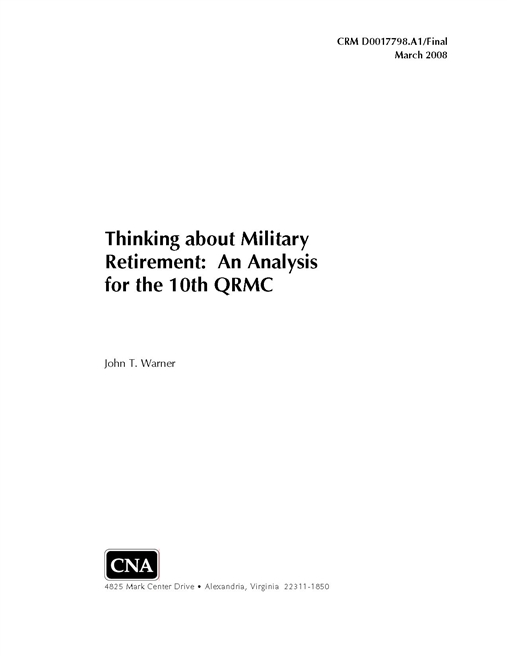The current military retirement system dates back to 1947, when Congress implemented a common 20-year system for all services and for officers and enlisted personnel alike. A reading of the a 1947 report by the Joint Army-Navy Pay Board and another report by the 1948 Advisory Commission on Service Pay (the Hook Commission) shows that the 20-year system was controversial from the start. Over the years, critics have charged that the system is (1) excessively costly and unfair to taxpayers, (2) inefficient, (3) unfair to the vast majority of entrants who do not serve long enough to receive any benefits, and (4) inflexible and hampers force management. Since 1972 a number of Department of Defense (DOD) study groups and independent commissions have recommended overhaul of the system. In 1986 the system was in fact modified in ways that would have provided smaller benefits to virtually all post-1986 entrants who reach retirement eligibility. But in the face of mounting criticism of the modified system (known as REDUX) from senior military leadership in the late 1990’s, Congress repealed it in FY 2000. With the repeal of REDUX, the 20-year system now seems more entrenched than ever.
However, discussion of the system continues. Three internal DOD study groups that were convened between 1998 and 2001 made the case for change and then-Secretary of Defense Donald Rumsfeld himself embraced the broad findings of these study groups. In the spring of 2005, he appointed seven members to the Defense Advisory Committee on Military Compensation (DACMC). The DACMC also endorsed the findings of the three internal DOD study groups and it made broad recommendations for reform that are intended to be turned into specific legislative proposals by the 10th Quadrennial Review of Military Compensation (10th QRMC).
The third section evaluates the past criticisms of the retirement system listed above. There are elements of truth to all of the criticisms. The current system is more costly than it could be, but not grossly so. The system is unfair to the personnel who serve for significant periods of time, but not long enough to qualify for retirement benefits (although the provision of other elements of compensation (e.g., bonuses) mitigates this criticism somewhat). The main problem is the inefficiencies that result from the severe limitations the retirement system places on personnel management. The military personnel management system is a one-size-fits-all system that lacks the capacity to adapt to ever-changing circumstances. Unlike the days when most military personnel were concentrated in the Combat Arms skills, today’s personnel perform a wide variety of tasks with much different skill sets. The military labor force is an increasingly heterogeneous work force, but is still being managed as if all personnel were in the so-called “youth and vigor” (Y&V) skills.
In my view, the personnel management system needs to be restructured to (1) provide more capacity to adjust force size and structure in a timely manner, (2) allow for more variation in career lengths across the wide spectrum of military skills, (3) provide for longer assignments to capture the returns to training, and (4) encourage generally longer careers for personnel destined to be senior leaders. Retirement reform is a key ingredient to a re-vamped system of personnel management.
The fourth section discusses the retirement reform recommendations of several past commissions and identifies the broad features of a revised system. DOD needs to communicate to personnel that the retirement system serves to distinct purposes and recognize those distinct purposes in policy. The first purpose of the retirement system is to help personnel accumulate for old-age. Today’s system does not perform this function very well for the vast majority of personnel. To help personnel accumulate for old age, personnel should be vested much earlier than they are today in an old-age benefit that might take the form of a defined benefit (as under today’s annuity system), the form of DOD contributions to military members’ Thrift Savings Plan (TSP) accounts, or some mix of defined benefits and defined contributions. The old-age part of the system would be an entitlement that personnel earn proportionally to the service that they render.
The second purpose of the retirement system is to improve force management by enabling DOD to separate personnel on good terms when it is in DOD’s interest to do so. This might mean encouraging separations prior to the 20-year mark in the Y&V skills but delaying them well beyond the 20-year mark in the human-capital intensive skills. DOD should establish a system of separation payments and manage the system separately from the old-age part of the system on a skill-by-skill basis. The separation payments might take the form of an annuity (as under the current system) or a lump-sum cash payment. But because they are intended to be a flexible force management tool, the separation payments are explicitly not an entitlement.
Opponents of change to the retirement system have argued that a new system would be too risky and would fail to provide the same quality force as the current system. The fifth section uses an economic model developed by Asch and Warner to estimate how the experience mix of the Army’s enlisted force would change under four alternative systems and how much costs would change. I find that three of these plans would maintain or increase the quality and average experience level of the force without an increase in cost. These plans would contribute to the old-age needs of a much larger portion of the force while providing DOD and the services with better force shaping tools. In sum, there is a case for changing the retirement system.
Download reportApproved for Public Release; Distribution Unlimited. Specific authority: N00014-05-D-0500.
Details
- Pages: 40
- Document Number: CRM D0017798.A1/Final
- Publication Date: 3/1/2008
